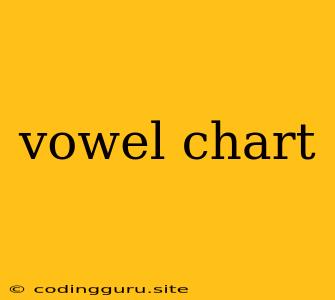The Vowel Chart: A Guide to Understanding Speech Sounds
The vowel chart, also known as a vowel diagram, is a visual representation of vowel sounds in a language. It's a crucial tool for understanding pronunciation, phonetics, and the complexities of language. But how do we navigate this chart and what information can we glean from it?
What Does a Vowel Chart Show?
A vowel chart maps out the various positions your tongue takes in your mouth when you produce vowel sounds. It's like a map of your mouth! The chart is typically a two-dimensional diagram with:
- Horizontal Axis: This axis shows the front-to-back position of your tongue, with sounds at the left representing front vowels (e.g., "ee" in "see") and sounds at the right representing back vowels (e.g., "oo" in "food").
- Vertical Axis: This axis indicates how high or low your tongue is in your mouth. Sounds at the top of the chart represent high vowels (e.g., "i" in "bit"), while sounds at the bottom represent low vowels (e.g., "a" in "cat").
Reading the Vowel Chart: An Example
Let's look at the English vowel chart. The most common representation includes the following vowels:
- i (as in "bit")
- ɪ (as in "bit")
- e (as in "bed")
- ɛ (as in "bet")
- æ (as in "bat")
- a (as in "father")
- ɒ (as in "hot")
- ʌ (as in "but")
- ʊ (as in "put")
- u (as in "food")
Each vowel is represented by a symbol, and these symbols are placed on the chart according to the position of your tongue when you produce the sound. For example, "i" is placed high and front because your tongue is in a high, front position when you make that sound.
Types of Vowel Charts
It's important to note that there are variations in vowel charts depending on the language. Each language has its own unique set of vowel sounds. For example, the English vowel chart is different from the Spanish vowel chart or the French vowel chart.
Why is the Vowel Chart Important?
Understanding the vowel chart is important for several reasons:
- Accurate Pronunciation: By using the chart, you can learn the correct position of your tongue for each vowel sound, helping you to improve your pronunciation.
- Learning New Languages: The vowel chart is a powerful tool for learning new languages, especially those with a different vowel system than your native language.
- Linguistics: The chart is a fundamental tool for linguists and phoneticians, enabling them to study the sounds of language and how they are produced.
Tips for Using the Vowel Chart
- Start with your native language: Begin by familiarizing yourself with the vowel chart for your own language. This will provide a foundation for understanding the sounds and their placement.
- Practice the sounds: Once you understand the chart, practice producing the vowel sounds by placing your tongue in the correct position.
- Use online resources: Many websites and apps provide interactive vowel charts that allow you to hear the sounds and see visual representations of the tongue positions.
- Consult a phonetics textbook: For a more in-depth understanding, consider consulting a phonetics textbook which explains the theory behind the vowel chart in detail.
Conclusion
The vowel chart is an essential tool for understanding the sounds of language and improving pronunciation. By understanding the relationship between vowel sounds and tongue positions, you can learn to speak more accurately and confidently. Whether you're a language learner, a teacher, or simply interested in the science of language, the vowel chart is an invaluable resource.
